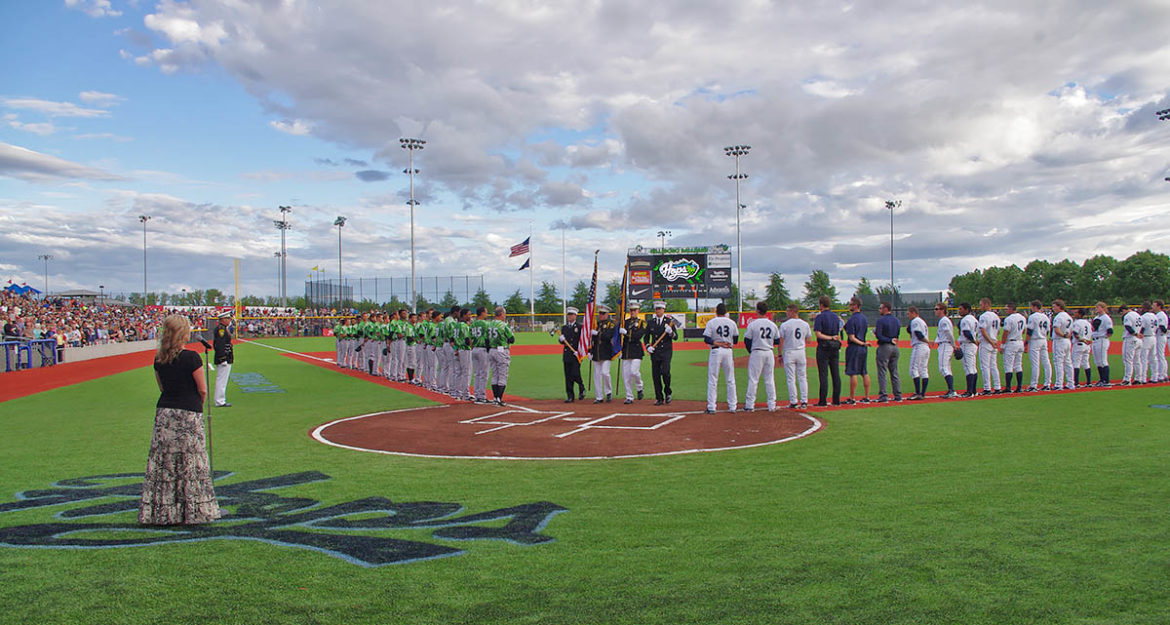Article and all photos by Joe Mock, BaseballParks.com
All rights reserved
Really, it was silly that Portland, Oregon had no professional baseball, wasn’t it? Wasn’t it unthinkable that the City of Portland tossed the Triple-A Beavers out of PGE Park — a stadium that was reconstructed to accommodate the return of baseball in 2001 — all because the City wanted that stadium to be a soccer-only facility? It was hard to fathom that the 24th largest metro area in America couldn’t find a way to provide a facility for the Beavers, thereby driving the franchise from the Pacific Northwest following the 2010 season.
|
Ballpark Stats |
|---|
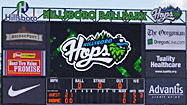 |
| Team: Hillsboro Hops of the short-season Northwest League |
| First regular-season game: June 17, 2013, a 12-0 blasting of the Eugene Emeralds |
| Capacity: 4,500 (3,700 fixed seats plus 800 general admission) |
| Architect: SRG |
| Construction: Hoffman |
| Price: $14.6 million |
| Home dugout: 1B side |
| Field points: south |
| Playing surface: Matrix Turf (artificial) |
| Betcha didn’t know: The only dirt to be found on the entire playing field is the mound and the circle containing the batter’s box. |
It took two years, but pro baseball is back in the Portland area, having hopped into town from Yakima, Washington.
The team formerly known as the Yakima Bears of the short-season Class A Northwest League is now the Hillsboro Hops, playing in a brand-new facility that is 14 miles due west of downtown Portland.
Don’t think for a second that this was a smooth, effortless event. The process was anything but.
For 20 seasons, the Bears called Yakima County Stadium home. During its last decade, it was anything but state of the art. The Bears’ management worked with the County, hoping a new stadium could be built. At a minimum, the old facility needed to be gutted and modernized.
When no reasonable progress was made, the Bears starting looking elsewhere. This coincided with the Beavers being ousted from PGE Park in the heart of Portland.
The Beavers had looked frantically around the suburbs of Portland for a place to play. They conducted serious discussions with the suburbs of Beaverton, Lents and, according to Hillsboro Mayor Jerry Willey, Hillsboro. “The Beavers talked to us. They wanted us to renovate our football stadium (to accommodate baseball) at a cost of $35 or $40 million. We said no thanks.”
The Beavers had no choice but to leave the market, moving temporarily to Tucson. That franchise will land on its feet, though, moving into a brand-new ballpark in downtown El Paso in 2014.
The Bears saw the immense opportunity of the wide-open Portland market. After all, the Northwest League once had a franchise there, and it did well enough to justify bringing Triple-A baseball back to town.
With the City of Portland showing incredible indifference toward pro baseball, the Bears decided to determine if a new ballpark could be a possibility in one of the suburbs. “We talked to the Yakima people early on,” Mayor Willey recalled. “It didn’t work out, but we kept up with the developments regarding their move.”
|
Left behind |
|---|
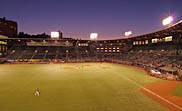 |
| Above is PGE Park during the last season (2010) it could be used for baseball. Today it is a soccer-only venue. Below is Yakima Stadium, the sub-par facility abandoned by the Bears. |
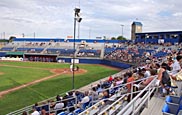 |
Just as the Beavers had done, the Bears spoke to various Portland suburbs, and it appeared for a while that they’d found a new home in Vancouver, Washington, which is just across the Columbia River from Portland. The Bears and Clark College seemed to find common ground, figurative and literally, as the plan called for the college’s current ballfield to be rebuilt into a facility that could host both college and pro ball. When I visited Yakima in 2011, Bears GM K.L. Wombacher excitedly showed me the renderings that 360 Architecture had prepared for that site. The renderings showed an absolutely gorgeous ballpark with extensive use of natural wood to blend with the tall pines around the site. Wombacher had even picked out a team nickname. Because this team would be the second one in the league to play in a city called Vancouver, he suggested his team be called the Vancouver Americans, as the one already playing north of the border is called the Vancouver Canadians. Wouldn’t it be neat when the Ams would host the Cans?
Alas, the City and County failed to approve an amusement tax that would’ve gone toward construction costs, so the ballpark idea for Clark College died. That meant the Vancouver Americans never came to be. Someone, though, was happy to hear that things hadn’t worked out on the other side of the river. “When the Vancouver plan failed, we contacted K.L. and asked if they were still interested in us,” recalled Mayor Willey. “He said, ‘Absolutely! You were our first choice anyway.'”
An agreement on the location within Hillsboro — an already-existing sports complex near a major highway — came quickly, and then the challenging work began. “The City wanted to show the team how much it wanted them to move there, so (the City) did a design-build competition,” explained Jeff Yrazabal, a principal at Portland’s SRG, the architects for the park. This process involved the City inviting teams of architects and construction companies to submit proposals together. “SRG and Hoffman (Construction, another local firm) submitted a proposal of a design and a suggested cost,” said Yrazabal. The duo made the finals, only to learn that the other finalist was the team of Populous, probably the most-accomplished sports architects in the world, and Mortenson, who had constructed such baseball projects as Target Field, Coors Field, Camelback Ranch, Salt River Fields and the rebuilding of Cheney Stadium in nearby Tacoma.
Talk about Goliath taking on David.
And just like in the 17th Chapter of First Samuel, David was victorious. And then came the really, really challenging part: the SRG-Hoffman team had to meet the time deadline required by the City. According to Matt Swaim, the Director of the Sports Group at Hoffman, “The first time that SRG and Hoffman got together was in mid-April of 2012. Early last July, we pinned down what the stadium was going to look like. From that point, the design and the construction took nine months,” an incredibly ambitious timeline indeed, especially when you consider the groundbreaking ceremony didn’t occur until September 21. “Yes, it was a big achievement,” added Yrazabal. “It took a lot of late nights and a great team to pull it off.”
|
Breaking news |
|---|
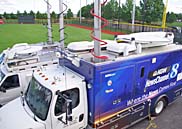 |
| Lest you think that residents and the media in Portland would be apathetic about pro baseball popping up out in the suburbs, consider this: the team issued credentials to a whopping 48 members of the media, and news crews from all four Portland TV stations were on hand to cover Opening Night of the new park. |
Two factors helped ensure the timely completion of the park. First, the Northwest League is a “short-season” circuit, so opening day for the pro team wasn’t until June. Second, Hoffman constructed the distinctive-looking football stadium that was already in the sports complex. As we’ll see, the relationship between the existing stadium and the new ballpark was the key element in this process.
When June 17, 2013 rolled around, the relocated Yakima Bears played their first game in Hillsboro Ballpark, having moved from easily the worst park in the league to arguably the best. The photo at the top of this page is from the ceremonies prior to that Opening Day game.
As the box on the right attests, local media interest was off the charts. One of the journalists on hand that evening was John Canzano, columnist for The Oregonian, Portland’s daily newspaper. In an article titled “Hillsboro speaks up for baseball, and what a big hit it is” that appeared the morning after the first game, he wrote: “…after a look around the stadium, I have no doubt this baseball adventure in Hillsboro is going to be a raging success. It’s going to spawn generations of baseball in the west suburbs and make Beaverton, Vancouver and Portland wish it could have had the guts to build a ballpark and pull this off.”
The baseball team the journalists were covering was no longer called the Bears. They were proudly called the Hillsboro Hops. “Hops was one of the names we’d been considering,” said Lauren Wombacher, the team’s Director of Merchandise, as well as being the delightful wife of K.L. “When we then held a name-the-team contest, Hops was one of the entries.” She pointed out that the nickname works on several levels: hops are an important local crop in Oregon that is used in medicines and, of keen interest to many baseball fans, beer; it utilizes alliteration, as Hillsboro and Hops start with the same letter; obviously, it’s a baseball term applied to a bouncing ball. It also allowed for a cute logo that, as we will see in The Essentials section below, has been incredibly popular.
So baseball hopped back into the Portland area with the arrival of the Hops and the opening of an intriguing new ballpark. Let’s take a closer look at the facility’s setting, its exterior, its unique interior design (joined at the hip with a football stadium) and the amenities for fans.
The Setting
As Mayor Jerry Willey proudly pointed out to me, Hillsboro has a population of 92,000, making it the fifth largest city in Oregon. (He also educated me about agriculture, informing me that hops is the State’s second biggest crop). That means that Hillsboro has almost exactly the same number of residents as Yakima, but that’s only a small part of the story. Hillsboro is the county seat of Washington County, which boasts a population of 530,000, which is all the more impressive when you consider that the City of Portland isn’t within its borders.
Is the population in Washington County sufficient to support a Class A baseball team? Easily. And when you factor in Portland’s population of nearly 600,000, you start to see why this was the largest market in the U.S. without pro baseball — and why it was so appealing to the Yakima Bears.
It’s important to note that the Hops don’t need Portland’s large population to make a go of it. Successful examples abound, like the suburbs of Frisco just outside of Dallas and Round Rock, which is just north of Austin. The large metro area makes the market appealing, but as time goes by, the teams in the suburbs draw a decreasing percentage of ticket holders from the large city next door. The crowds end up being comprised of locals who live within ten miles of the ballpark, as the then-president of the Round Rock Express explained to me several years ago.
Frankly, the Hops can be quite successful with fans only coming from Washington County. As Mayor Willey told me, “What will really help make this work is that Beaverton (the State’s sixth largest city, with a population of 91,000) is right next door. Our populations can certainly support a team.”
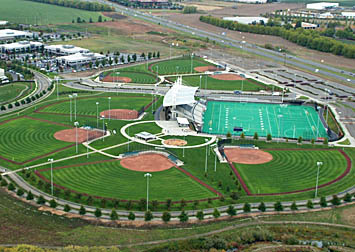 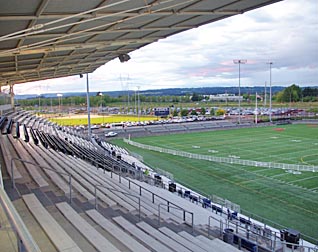 |
| On the left is the way the Gordon Faber Complex looked prior to the start of construction of the ballpark. Today, the Hops’ park is directly behind the stands for the football stadium, but home plate is at the north end of the spot, not at the south like shown here. (Photo courtesy of the City of Hillsboro) On the right is the interior of the football stadium, which was designed to also accommodate lacrosse, soccer and two baseball/softball fields. The new baseball stadium is to the left (back) of these football stands. |
Hillsboro Ballpark was constructed in an already existing recreation area, the Gordon Faber Recreation Complex, which was named for former Hillsboro mayor and long-time city councilman Gordon Faber. The complex is in the northeast corner of the city, next to U.S. Route 26, a major expressway that is also called the Sunset Highway. This roadway makes it quite convenient for fans from Beaverton and Portland to come to see the Hops play. They just drive up the Sunset Highway and exit at Cornelius Pass Road and follow the signs for the remaining mile to the complex’s 2,000 parking spaces. Most of the spaces are along the northeastern edge of the Complex, which means you’ll have to walk along the northern periphery of the football stadium to get to the ballpark’s entryway. If you think you’re taking a shortcut if you walk around the southern edge of the football stadium, you’ll learn that there are no entry gates for the park there.
The Pacific Northwest prides itself on its heavy usage of public transportation. Unfortunately, the closest stop on the MAX commuter light-rail system is two miles from the Gordon Faber Complex, at Orenco Station. When Tri-Met, the transportation authority, turned down the Hops’ request to extend bus service late enough to accommodate fans going to and coming from games, the team met the challenge. They decided to pay for shuttle buses to take fans from and back to the Orenco Station. The shuttles are free for anyone who can show they paid for a MAX ticket.
The area surrounding the Complex has quite a bit of commercial development. Consequently, if you’re looking for fast food on your way to or from a game, you’ll pass a number of options between the U.S. 26 interchange and the ballpark along NW Imbrie Drive.
Before the Hops came along, the Complex itself (shown in the left-hand photo above) included a cluster of facilities that included four softball fields and the 7,000-seat football stadium, and three smaller ballfields across a parking lot. “We wanted to minimize the number of (softball) fields it would take to build the Minor League ballpark,” said Mayor Willey, and the SRG/Hoffman accomplished that beautifully. Only one field needed to be eliminated to make way for the pro-baseball stadium. They did this by re-orienting that field so that home plate was in the northern part of the space, and by more-or-less attaching the new ballpark to the back of the football stadium’s main grandstand.
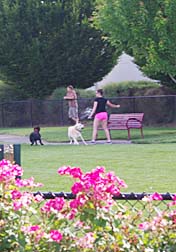 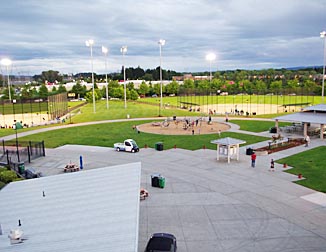 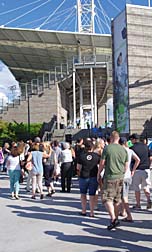 |
| On the left is the Hondo Dog Park, directly across the street from right field. In the center is the view of the Complex from the upper (outer) concourse of the football stadium. The baseball park is to the right of this scene. In the picture on the right, fans are gathered outside the gates, waiting to watch the park’s first game. The stands in the upper left belong to the football stadium. The tower in the upper right contains the elevator shaft of the ballpark. |
By the way, an adorable play area for canines, called the Hondo Dog Park, is directly across 229th Avenue from right field of the ballpark. Interestingly, there’s an enormous campus of buildings for Intel a couple of hundred feet farther south on 229th.
Because the ballpark faces south — which is quite unusual for a pro-baseball stadium –the sun sets behind the first-base stands. There are some pretty sunsets over Oregon’s Coastal Range, but you won’t have a clear view of the mountains themselves from the seats. Similarly, massive Mount Hood, the volcanic peak about 50 miles east of Portland that is one of the State’s most famous sights, isn’t visible from here.
Let’s take a look at the ballpark itself.
